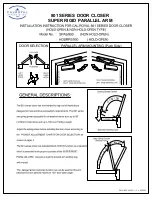
9
OPERATION
9
(STEP 3) Second Press: The output ramps down to
the level set with the Start/Crater Current control.
The time it takes to ramp down is set with the Down
slope Time control. (Approx. 0.5 to 10 seconds)
(STEP 4) Second Release: Output is turned off stop-
ping the weld and a 15 second Postflow of shielding
gas is applied.
1. If connecting a Lincoln LA-9 or LA-17 TIG torch con-
nect the Twistmate plug to the receptacle located on
the front of the machine. See INPUT SUPPLY CON-
NECTIONS if another TIG torch is used.
2. Set the MODE switch to
“
4-STEP TIG
”
3. Set the Polarity Switch to DC- for welding steel or
stainless steel; or to AC for welding aluminum.
4. Connect an Arc Start switch or Amptrol to the
Remote Control Connector.
5. Turn on the cylinder gas valve and adjust the flow
regulator to obtain the desired flow.
6. Turn the power switch to
“
ON - I
”
. NOTE: There will
be a 15 second gas flow when the power is turned
on.
7. Set the Current Control on the control panel to the
maximum desired amps.
8. Set the Start/Crater Current control
on the control panel to obtain the desired level as a
percentage of the maximum current. Note: The level
set must be above the machines minimum starting
level. (12 Amps)
9. Set the Down slope Time control
on the control panel to the desired level.
10. Depress the Arc Start switch or Amptrol to energize
the torch and establish an arc at the Start current
level with the work piece.
11. Release the Arc Start switch or Amptrol to ramp up
to the maximum current setting.
12. Depress the Arc Start switch or Amptrol again to
start the Down slope time.
13. Release the Arc Start switch or Amptrol to stop
welding.
NOTE: When the polarity switch is set to DC, the TIG
Arc Starter will turn on and off automatically to start
and stabilize the arc. In AC the TIG Arc Starter will turn
on with the output and remain on continuously until the
remote control is released.
REMOTE CONTROL OPERATION
A Foot Amptrol
™
is included with the Square Wave TIG
175 for remote current control while TIG welding. An
optional Hand Amptrol may also be used. An optional
Arc Start Switch may be used to start and stop the
welding if no remote control of the current is desired.
Refer to the Accessories section of this manual.
Both the Hand and Foot Amptrol work in a similar man-
ner. For simplicity, the following explanation will refer
only to
“
Amptrols
”
, meaning both Foot and Hand mod-
els. The term
“
minimum
”
refers to a foot pedal in the
“
up
”
position, as it would be with no foot pressure, or a
Hand Amptrol in the relaxed position, with no thumb
pressure.
“
Maximum
”
refers to a fully depressed Foot
Amptrol, or a fully extended Hand Amptrol.
When the welder is in 2 Step TIG mode activating the
Amptrol energizes the electrode terminal and varies
the output welding current from its minimum value of
10 amps, to the maximum value set by the Current
Control on the control panel. This helps eliminate acci-
dental high current damage to the work piece and/or
tungsten, and gives a fine control of the current. When
the welder is in 4 Step TIG mode the Amptrol acts as
an Arc Start Switch. When the welder is in the stick
mode a remote control has no effect and is not used.
It is important to note that, in some cases, the tungsten
will not start an arc at the minimum current because
the tungsten may be too large or cold. To start an arc
reliably, it is important to depress the Amptrol far
enough so that the machine output current is near the
tungsten operating range. For example, a 3/32
”
tung-
sten may be used on DC- to weld the full range. To
start the weld, the operator may have to turn the cur-
rent control up and depress the Amptrol approximately
1/4 of the way down. Depressing the Amptrol to its min-
imum position may not start the arc. Also if the Current
Control or Start/Crater current is set too low, the arc
may not start. In most cases, a large or cold tungsten
will not readily establish an arc at low currents. This is
normal. In DC-, the Square Wave 175 will start a 3/32,
2% thoriated tungsten electrode at 15 amperes provid-
ed the electrode tip is properly grounded and not con-
taminated.
BENEFITS OF THE SQUARE WAVE DESIGN
In AC TIG welding of aluminum, the positive portion of
the AC wave provides
cleaning
(removal of aluminum
oxide) of the work piece. This is desirable on materials
with a heavy oxide coating such as aluminum. However
SQUARE WAVE TIG 175
A
Summary of Contents for SQUARE WAVE IM607
Page 29: ...NOTES SQUARE WAVE TIG 175 ...
Page 30: ...NOTES SQUARE WAVE TIG 175 ...
















































